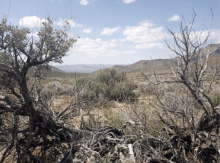Many of the desert plants do indeed resemble ocean creatures: coral-like cactus and urchin-like succulents. Although it is commonly thought of as desolate and emptiness, the high desert steppe is incredibly abundant and alive. 350 species of wildlife and insects depend just on sagebrush herself. … There is so much in the sagebrush sea, so many plants with lineages enmeshed with the Indigenous Tribes who traditionally tended them. The ecology of the high desert steppe exist in part due to the intentional cultivation of these plants to create future abundance. … These First Food plants have evolved to be prolific in the mosaic of seasonal gathering areas, in “wild gardens” that were tended for many generations before European colonization…. Pee hee Mu’huh, also known as Thacker pass, exists in the northeast region of Northern Nevada, close the Oregon border. It is and has been a corridor of travel and migration for many beings, and is part of the homelands of Paiute, Shoshone and Bannock people. It is a sacred burial site where there have been two known massacres and holds 1,000 cultural sites. There has been an ongoing resistance campaign since January 2021 to stop Lithium Nevada Corporation from moving forward with their plans to destroy this place with a 17,933 acre open pit mine.
Botany as Archaeology, to Stop a Lithium Mine

Many of the desert plants do indeed resemble ocean creatures: coral-like cactus and urchin-like succulents. Although it is commonly thought of as desolate and emptiness, the high desert steppe is incredibly abundant and alive. 350 species of wildlife and insects depend just on sagebrush herself. … There is so much in the sagebrush sea, so…
–
Originally Published in
